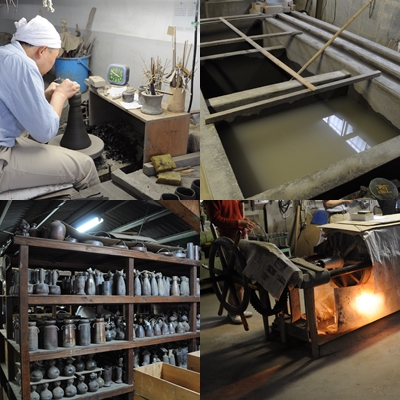Japanese Potteries(Explanations to the technical terms of ceramics No.16)
There are various technical words on potteries. Here are some of those, for which I'd like to give you some remarks.
Living National Treasure (in Ceramic Arts)
There is a recognition scheme for so-called Ningen Kokuho (or Living National Treasure) in Japan. The word, Ningen Kokuho, is for the common use and, in the official term, it is the “Holder of Important Intangible Cultural Property. EThis scheme is for the purpose to preserve personal skills, and those who have been accredited must strive to preserve and pass down the skill. 34 persons have been certified so far in the field of ceramic arts that are divided into 16 technical specialties such as “iroejiki (porcelains decorated with a colored picture E “hakuji or seihakuji (white porcelains) E “seiji (celadon porcelains) E “saiyu-jiki (glazed earthenware) E “sometsuke (blue and white-dyed porcelains) E “tetsuyu-jiki (iron-glazed earthenware) E “mingei-jiki (folkcraft porcelains) E “Ryukyu-jiki (Okinawa porcelains) E “Bizen-yaki (bizen ware) E “Hagi-yaki (Hagi ware) E “Tokoname-yaki (Tokoname ware) E “Karatsu-yaki (Karatsu ware) E “Shino/Setoguro (Shino/Setoguro ware) E “tetsue (underglaze iron decoration) E “neriagede (marbled ware) E “sansai (tricolored ware) E and so on.
Preservation of the traditional skills can be possible only by personal handing down through the actual works and practices to be observed and experienced. Therefore, the living national treasures have important roles to hold lecture meetings or go to a workshop and pass down the skills to promising successors. I have ever heard a story that even schoolfellows who have graduated from the same school mustn’t meet and talk if they are once apprenticed to different mentors. It may be true if there are conflicts of interest between the persons or the groups. However, in the extent of national preservation of traditional skills, the succession of the mystic techniques to prospective successors means everything. No numerical description on the subtle difference of clay’s or glaze’s composition will be beyond the practical experiences. It will be an only path to preserving the traditional skills that the successors acquire the sense of hangs. Appreciators may become more and more attracted to ceramic arts if they could admire the crafts and sense the unaltered or ever-developing techniques and works.

